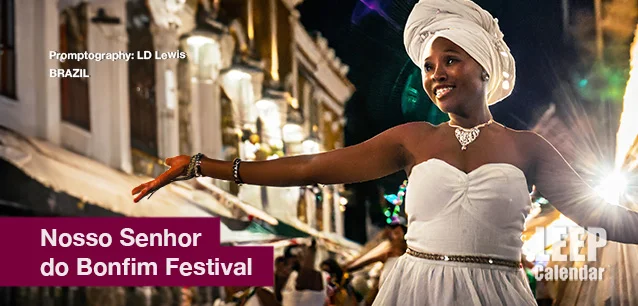 AD
AD
Today is: November 21
Scroll to explore events active on this date.
Additional Events on LEEP
LEEP INK FEATURES

August is Appropos
A toddler playing in the fountain at a park in Santa Fe, New Mexico—Photo LD Lewis. In August, we live through the Dog Days of Summer. It's hot and often humid, and those ...

September is Sassy
Can you hear that sigh of relief from parents worldwide? Yes! September marks the return of students to school, a global phenomenon. Preparations for the ACT and SATs begin earnestly for ...

OOH LA LA, October
October is the busiest month for events, with 5% more happening than in May, the second most eventful month. Sailing enthusiasts will be glued to the finals of this year's Am...
About Brazil's Nosso Senhor do Bonfim Festival
Brazil & South America
Ends: Jan 21, 2024
DESCRIPTION:
The Nosso Senhor do Bonfim Festival (Our Father of Happy Endings) is a vibrant and deeply spiritual event that annually graces Salvador in the northeastern state of Bahía, Brazil. It is a fusion of Catholic and Candomblé traditions.
Candomblé is an Afro-Brazilian religious tradition created during the colonial. Most Candomblé people are descendants of slaves. Their culture combines elements of African traditions, particularly those of the Yoruba, Fon, and Bantu peoples, with influences from Roman Catholicism. At the heart of this celebration is the Nosso Senhor do Bonfim church, an iconic religious site.
Participants wear traditional white attire and embark on a procession that stretches approximately eight kilometers (five miles) from the Church of Conceição da Praia (Church of the Conception by the Beach) to the Nosso Senhor do Bonfim church. This pilgrimage blends joyous chants, music, dancing, and fervent prayers bolstered by images of Jesus and Candomblé deities.
One of the most striking symbols of this festival is the "fitas", or wish ribbons, usually in vibrant hues. Ribbons are tied to the church gates or worn on wrists; each knot represents a wish or prayer. Festival goers believe their wishes come true once the ribbon falls off naturally.
The festival features an intriguing ritual known as the "Lavagem do Bonfim" (Washing of the Bonfim). Women dressed in baianas, a traditional Bahian attire, ceremonially wash the church's steps. This act, imbued with religious significance, is said to purify the church and attract blessings for the new year.
The ten-day festival includes culinary delights, music, and street dancing. The rhythms of samba and Afro-Brazilian beats resonate throughout the city, making the Nosso Senhor do Bonfim Festival a favorite with locals and tourists alike.
VIDEOS
SUPPORTING DOCUMENTS
Currently, this event does not have supporting documents.
ADDITIONAL IMAGES
Currently, this event does not have supporting images.
Where would you like to go now?
 AD
AD


/footer-logo.svg)
